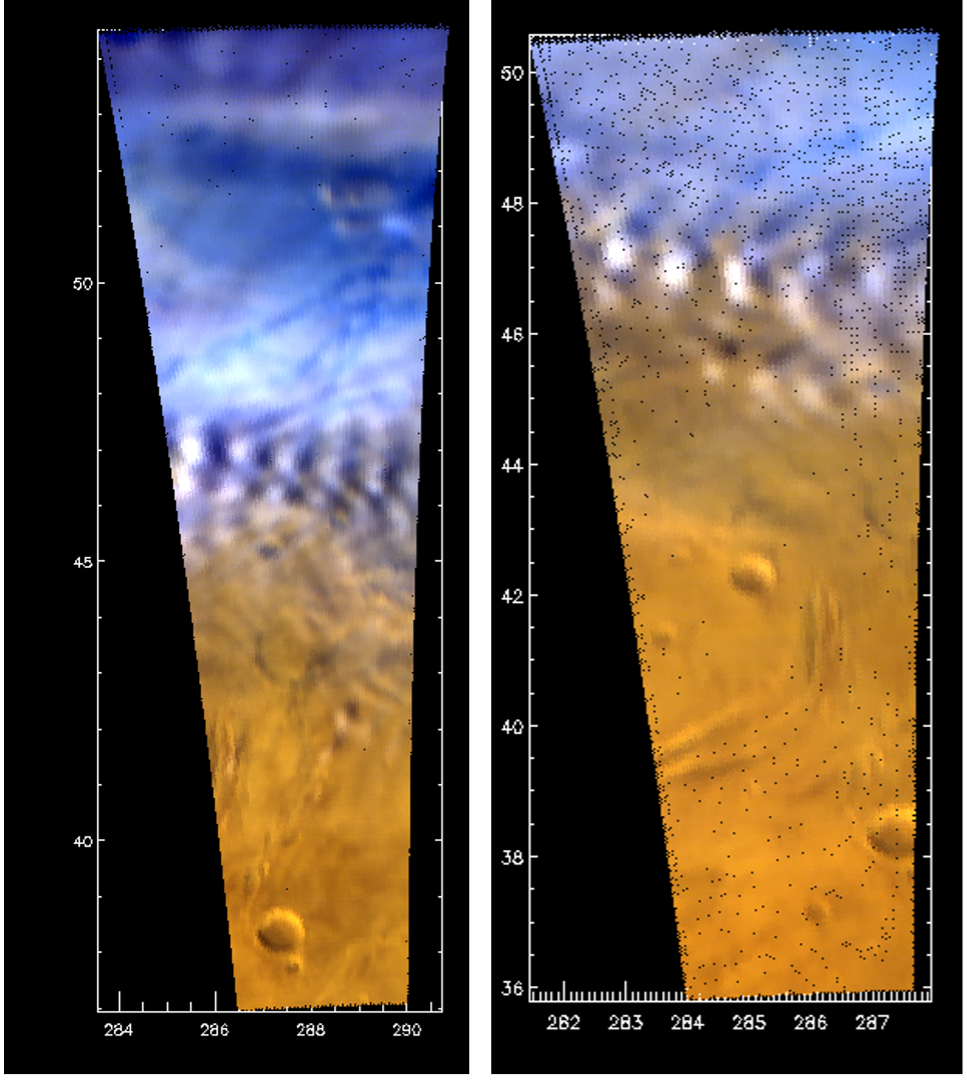Characterising Atmospheric Gravity Waves on Mars using Mars Express OMEGA images – a preliminary study
- 1Institute of Astrophysics and Space Sciences, Lisbon, Portugal (fbrasil@oal.ul.pt)
- 2European Space Astronomy Centre, Spain
- 3Institut d'Astrophysique Spatiale, (CNRS, Université Paris-Saclay), Orsay, France
We report preliminary result of the systematic detection and characterisation of atmospheric gravity waves on Mars' atmosphere, using observations carried out by the OMEGA (Observatoire pour la Minéralogie, l'Eau, les Glaces et l'Activité) [1] imaging spectrometer on board of the Mars Express (MEx) [2].
Gravity waves are mesoscale atmospheric oscillations in which buoyance acts as the restoring force [3]. The presence of gravity waves is observed in many of the Solar System planets atmospheres, from Venus [4], Earth [5], Jupiter [6], and being a crucial factor in the circulation of planetary atmospheres since they transport momentum and energy, which can dissipate at different altitudes and force the dynamics of several layers of the atmosphere.
The source of these waves can be associated with the topographic features (orographic gravity waves) of surface, or with jet streams and atmospheric convections (non-orographic gravity waves). Recent modelling studies showed the strong role of gravity waves on diurnal tides on Mars atmosphere [7], however their characteristic are still not well constrained by observations.
This work aims to go through the complete OMEGA data set to fully detect and characterise gravity waves observed during the Mars Express space probe. Every image was navigated and processed in order to optimise the detection of the wave packets and accurate characterisation of the wave properties such as the horizontal wavelength, packet width, packet length and orientation.
Due to the longevity of the MEx space mission, acquiring over more than 17 years of observations of the surface and atmosphere of Mars in nadir and limb modes, the OMEGA instrument offers an opportunity to explore the atmosphere dynamics over the years, especially the evolution of gravity waves along the time, due to the time sampling and global coverage of MEx.
The OMEGA images are composed of a hyperspectral cube with a spectral range of 0.38 to 5.1 m, taken with the visible and near-infrared (VNIR) and infrared (SWIR) spectrometers. We retrieved the OMEGA data and its IDL routines through the PSA archive from ESA, to produce OMEGA images which were later navigated and processed individually using ENVI software for optimal detection of wave features and accurate characterisation of wave properties, such as the horizontal wavelengths, packet width, packet length, location and orientation. Since the orbit has a certain resonance with respect to the Martian surface rotation (variable duration along the mission), there will be an overlapping of images taken, allowing the study of the evolution of gravity waves along a period of time and also the study of their activity during dust storms [8].

Figure 1 – Evolution of an atmospheric gravity wave packet detected in orbit 43 on Mars atmosphere using the OMEGA instrument on board Mars Express.
Acknowledgments: We acknowledge support from the Portuguese Fundação Para a Ciência e a Tecnologia (ref. PTDC/FIS-AST/29942/2017) through national funds and by FEDER through COMPETE 2020 (ref. POCI-01-0145 FEDER-007672).
References
[1] Bibring, J. P., et al. OMEGA: Observatoire pour la Minéralogie, l'Eau, les Glaces et l'Activité. In: Mars Express: the scientific payload. 2004. p. 37-49.
[2] Chicarro, A.; Martin, P.; Trautner, R. The Mars Express mission: an overview. In: Mars Express: The Scientific Payload. 2004. p. 3-13.
[3] Fritts, D. C.; Alexander, M. J. Gravity wave dynamics and effects in the middle atmosphere. Reviews of geophysics, 2003, 41.1.
[4] Silva, J. E., et al. Characterising atmospheric gravity waves on the nightside lower clouds of Venus: a systematic analysis. Astronomy & Astrophysics, 2021, Volume 649.
[5] Hines, C. O. Gravity waves in the atmosphere. Nature, 1972, 239.5367: 73-78.
[6] Young, A. et al. Gravity waves in Jupiter's stratosphere, as measured by the Galileo ASI experiment, Icarus, 2005, Vol 173, p. 185-199.
[7] GILLI, G., et al. Impact of gravity waves on the middle atmosphere of Mars: A non‐orographic gravity wave parameterization based on global climate modeling and MCS observations. Journal of Geophysical Research: Planets, 2020, 125.3: e2018JE005873.
[8] Gondet, B.; Bibring, J. P. Mars observations by OMEGA/Mex during the dust events from 2004 to 2019. In: EPSC-DPS Joint Meeting 2019. 2019. p. EPSC-DPS2019-94.
How to cite: Brasil, F., Machado, P., Gilli, G., Cardesín-Moinelo, A., E. Silva, J., Espadinha, D., and Gondet, B.: Characterising Atmospheric Gravity Waves on Mars using Mars Express OMEGA images – a preliminary study, Europlanet Science Congress 2021, online, 13–24 Sep 2021, EPSC2021-188, https://doi.org/10.5194/epsc2021-188, 2021.

